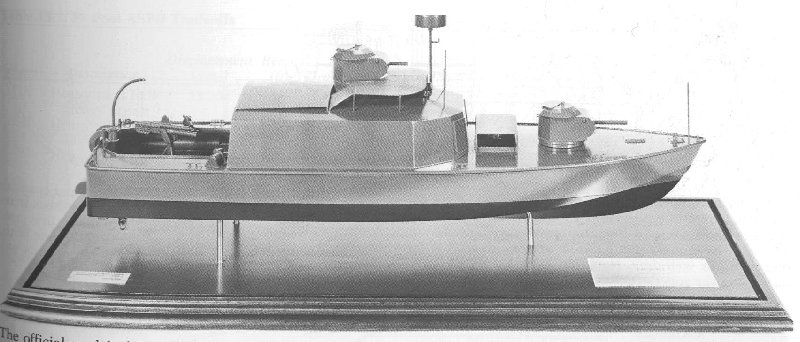

The following extracted from U.S. SMALL COMBATANTS, An Illustrated Design History, by Norman Friedman, U.S. Naval Institute Press, 1987
The assault support patrol boat (ASPB) was the only entirely new craft of the riverine navy. In 1965, NAGP (Naval Advisory Group) conceived it as an American successor to the French STCAN, sharing that boat's shallow draft (maximum 3 feet 6 inches) and antimine hull form and construction ( 5/16-inch steel with large scantlings). The ASPB would be used for escort, fire support, and mine sweeping during a U.S. river assault. It would, therefore, be extensively armored above the waterline: like the LCM conversions, it would have dual-hardness steel to defeat.50-caliber armor piercing bullets at 20-meter range, and it would have quarter-inch STS over its engine room. The ASPB would also have the same radios as the LCM, two VRC-46s and one PRC-25.
The most important ASPB characteristics were (1) speed in excess of the speed of the LCM; (2) fire power for gunfire support and protection; (3) armor to protect the crew and vital boat machinery; (4) minimum draft and maximum maneuverability, a turning circle of 50 feet at 6 knots, to allow flexibility in canal assault-support and blocking operations; and (5) mine-resistant hull design (capable of withstanding an explosion of a 55-kg (TNT equivalent) mine). Quiet operation would be important for canal-blocking operations.
The final design resulted in the crew's battle stations being armored against 7.62mm armor-piercing bullets at 75 meters. The coxswain's armored position was large enough to incorporate the radio/radar/depth finder operator position. Instead of bar armor, the ASPB had a new type of protection. It used a thin, quarter-inch aluminum trigger plate at a 22-inch standoff. Weight was so critical that 5/8-inch dual-hardness armor had to be used behind the trigger plate. This brittle plate could shatter when struck by delayed-fuse shells, which failed to detonate on the aluminum trigger plate. This kind of catastrophic failure, first experienced in July 1968, caused many casualties. It was solved after July 1969 by installing fragment suppression immediately behind the armor plate to stop the large, flat pieces before they rotated into a cutting position.
ASPBs were armed with two Mark48 combination turrets: (most commonly) one forward with a twin .50-caliber machine gun, and one above and abaft the pilothouse (coxswain and radioman's position) carrying a single 20mm cannon. ASPBs also had two single .30- to .50-caliber machine guns and a grenade launcher in their after cockpits. Other ASPB features included a chain-drag (mine) sweep, and an underwater exhaust for silencing.
The first thirty-six boats and one test platform were ordered from Gunderson Brothers Engineering Corporation, Portland, Oregon, on October 25, 1966. These boats were followed by fifty program 5 craft ordered on January 24, 1968. The first ASPB arrived at Vung Tau on September 20, 1967.
In March 1968, the sinking of five ASPBs (only two by enemy fire) in less than thirty days prompted the commander of River Flotilla 1 temporarily to curtail ASPB operations to the minimum required for combat. On March 2, A-91-1 was swamped by the wake of two passing ASPBs; it sank in less than one minute at the junction of the Can Tho River and the Ba Long Stream. The boat was recovered on March 6. This was not to say that the ASPB was unduly vulnerable to enemy fire. On March 1, A-112-8 and M-112-1 were hit by several B40 rockets in the Can Tho River while covering the salvage of A-112-4, which sunk on February 27. A-112-8 took a direct B40 hit in her engine cover and had to be towed back. A-112-4 was recovered and towed to Can Tho on March 4.
On March 14, 1968, A-92-7 sank on the Sam Giang River after a rocket hit it directly on the stern below the waterline. Salvage was not feasible, so the boat was stripped and destroyed in place by an explosive ordnance disposal team.
Eleven river assault craft were damaged on April 4. A-92-1 and A-92-4,
which suffered the most, were hit by a total of six RPG-7s. These were
direct hits on .50-caliber mounts. In the same action, M-92-2 was hit by
a heat round that penetrated the opening between the 20mm and .50-caliber
mounts, killing the captain and coxswain. An ATC took an RPG-7 round through
its bow ramp, which severed the ramp winch cable and wounded thirty army
personnel in the well deck. Another ATC was hit near the waterline by an
RPG-7. It triggered on bar armor, penetrated the bulkhead, and created
a shrapnel effect in the empty well deck.
The ASPBs were known as delta destroyers because of their speed
and firepower. In retrospect, the speed was almost irrelevant, as formations
were only as fast as their slowest components, the 6-knot armored troop
carriers (ATC).
Specifications:
Material: Steel
Length: 50' 1.5"
Beam: 15' 2.5"
Draft: 4' 3"
Engine: 2 GM diesels 12V71 developing 430
horsepower
Speed: (officially) 16 knots
Fuel: 650 gallons
Endurance: 130 nautical miles @ 10 knots
Cost: $325,000
Displacement: Full load approximately 77,000 pounds
Crew: 5 (Boat captain/coxswain, radioman,
engineman/gunner, .50-cal gunner, 20mm gunner)